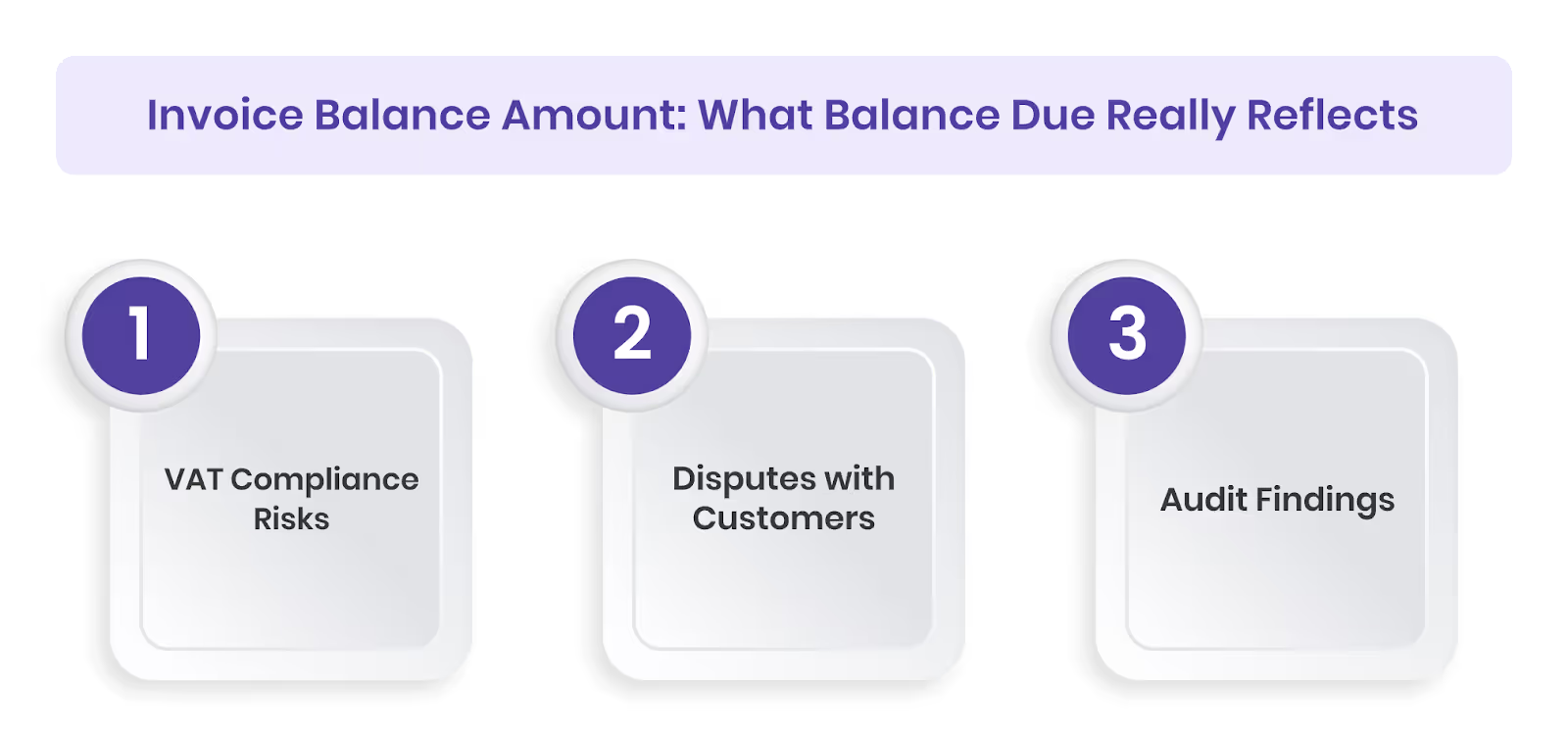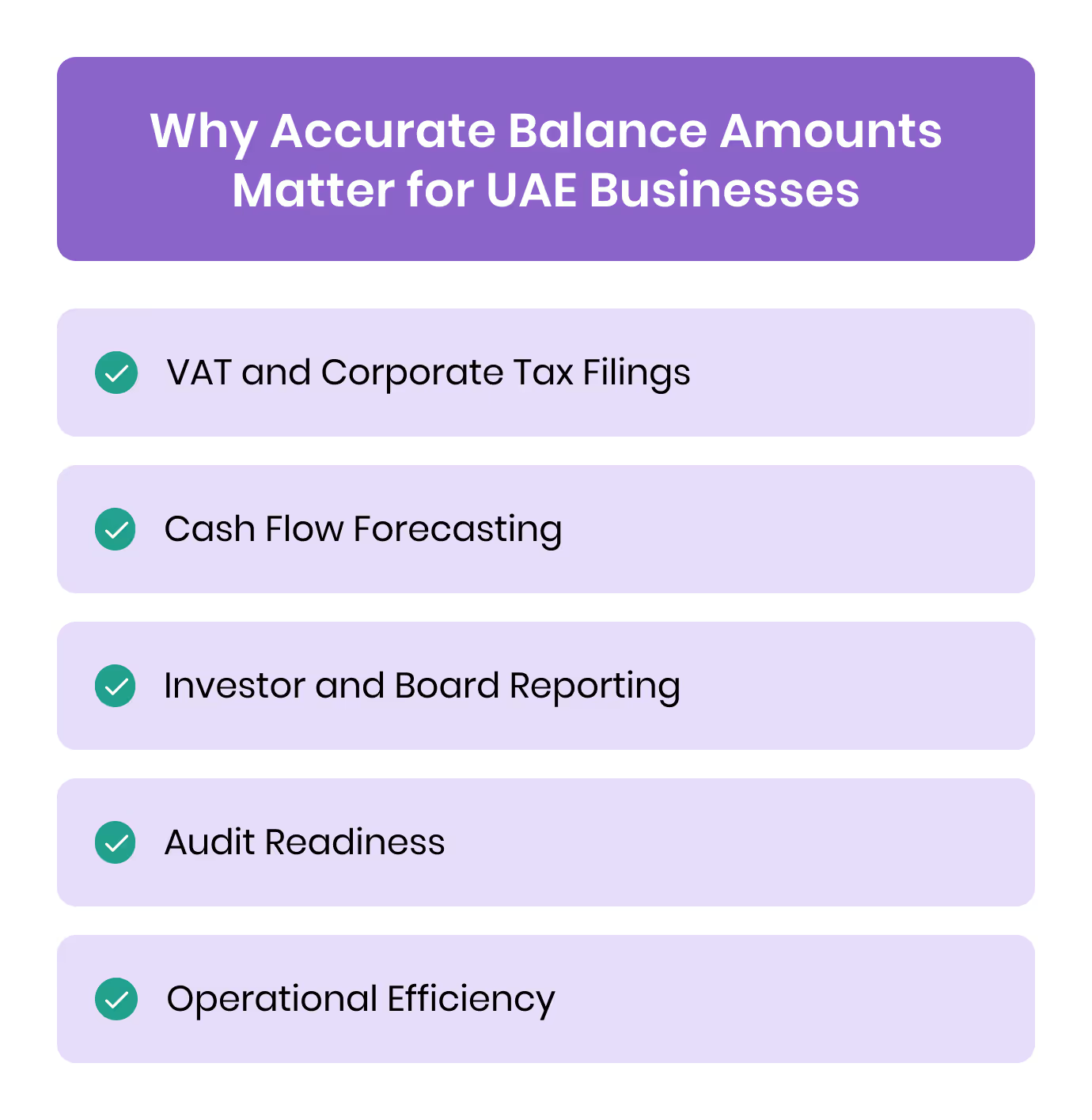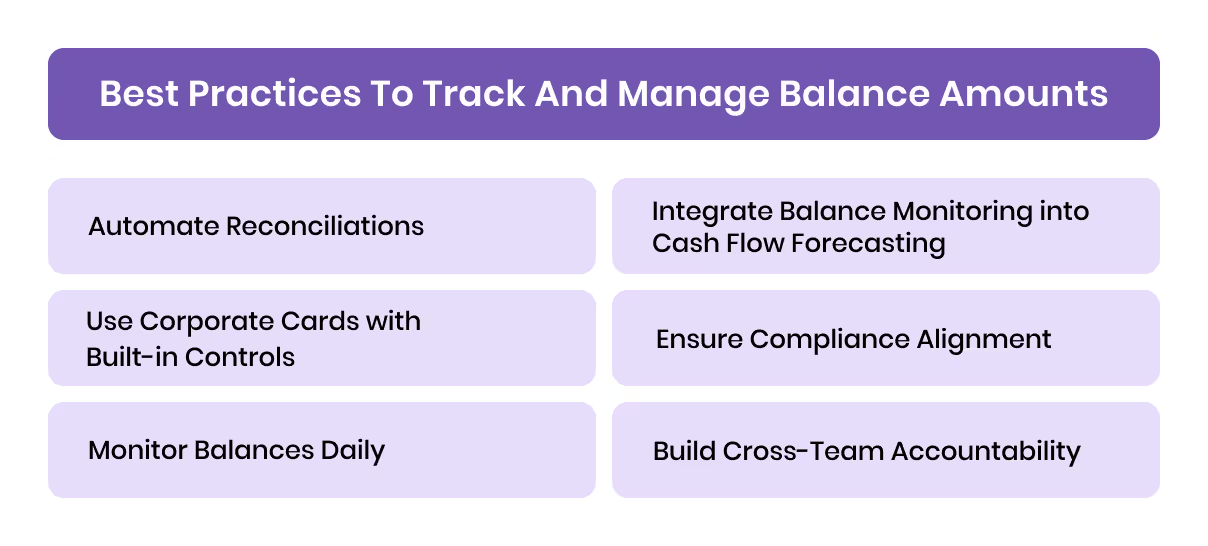For finance teams, every misstatement begins with a wrong balance. A seemingly small error in a balance amount can ripple across the organisation—VAT claims get rejected, auditors flag discrepancies, and investors start questioning the reliability of reports.
In the UAE, where companies must comply with 5% VAT and 9% Corporate Tax, the precision of balance amounts is more than a bookkeeping detail—it is a compliance obligation. Clean balances determine whether financial statements withstand regulatory scrutiny, whether banks extend credit, and whether boards trust the numbers they see.
In this article, we clarify what balance amount really means in accounting, how it differs from banking usage, where it shows up in invoices, and why it is central to compliance and audit readiness in the UAE.
Key Takeaways
- Balance amount goes beyond a bank figure — it spans book balances, available balances, and invoice balances, each critical for decision-making.
- Accuracy drives compliance in the UAE — misstatements can distort VAT filings, Corporate Tax returns, and audit outcomes.
- Bank vs business balance — the difference between available funds and ledger entries directly impacts cash flow forecasting and liquidity.
- Automation is no longer optional — tools like corporate cards, reconciliations, and real-time dashboards ensure visibility and reduce manual error.
- Strategic advantage — businesses that track balance amounts proactively gain credibility with auditors, investors, and regulators while reducing operational risk.
Balance Amount in Accounting: Core Definition and Meaning
In accounting terms, a balance amount is the net position of an account at a specific date—the difference between all debit entries and all credit entries recorded. Put simply, it’s what the books say you have left after offsetting inflows and outflows.
But finance leaders know that not all balances are created equal. Each type of account carries a “normal balance” that signals whether debits or credits are expected:
- Assets and expenses usually carry a debit balance.
- Liabilities, equity, and revenue usually carry a credit balance.
When an account shows the opposite (for example, a credit balance in cash), it’s not just a quirk of bookkeeping—it’s often a red flag indicating overdraft, misposting, or timing mismatches. This is where account balance accounting goes beyond mechanics: it’s about interpreting what balances reveal about the health of the business.
For CFOs and controllers in the UAE, balance amounts are not just ledger snapshots. They feed directly into monthly management packs, external audits, and statutory filings. A misclassified or abnormal balance doesn’t just distort internal reporting; it can affect VAT reclaims, corporate tax calculations, and even creditworthiness with local banks.
Also read: Understanding ledgers in accounting
Balance Amount in Banking vs Business Books
When most people hear “balance amount,” they think of what’s left in a bank account. But in practice, there are two different balances to consider:
- Book balance – what the company’s ledger or the bank’s records show at a given point in time.
- Available balance – what can actually be spent, after pending transactions, card authorisations, and holds are cleared.
For corporate finance teams, the difference between these numbers is not trivial. Consider a scenario:
- Your ledger shows AED 1,000,000 in cash (book balance).
- But AED 250,000 in supplier payments are pending clearance, and AED 150,000 in employee card authorisations are on hold.
- The available balance is therefore only AED 600,000.
If treasury teams plan payroll or debt repayments based on the higher number, liquidity risk emerges.
In the UAE, where many industries are still moving away from cash-heavy processes, this distinction is critical. Regulators and auditors expect cash balances to reconcile with actual available funds. Banks, too, evaluate available balance when considering overdraft limits or extending credit.
Finance leaders should ensure that cash forecasting models incorporate both book and available balances—especially when reporting to boards or external stakeholders. This avoids overstating liquidity and prevents unpleasant surprises during audits or tax reviews.
Also read: Cash flow management for businesses in the UAE
Invoice Balance Amount: What “Balance Due” Really Reflects

Outside ledgers and bank statements, the term balance amount is also used on invoices—usually to indicate the balance due after factoring in previous payments, credits, or adjustments.
A simple formula explains it:
Opening Balance + New Charges – Payments/Credits = Balance Amount (Due)
On paper, this looks straightforward. But in practice, errors in invoice balances can cause cascading problems:
- VAT compliance risks: In the UAE, VAT invoices must reflect accurate taxable amounts. If the invoice balance is overstated or understated, VAT input claims may be rejected during audits.
- Disputes with customers and vendors: A mismatched invoice balance leads to back-and-forth reconciliations, delayed collections, and strained supplier relationships.
- Audit findings: Auditors often test invoice balances against ledger entries. Any gap between what’s billed and what’s posted in the books becomes an audit adjustment.
For finance teams, invoice balance accuracy is not just about faster collections—it is about credibility and compliance. That’s why more UAE companies are moving toward digital invoice matching and automated reconciliations, where systems validate invoice balances against VAT requirements and accounting entries in real time.
This ensures that what appears as “balance amount due” on an invoice is not only correct, but also audit-ready and VAT-compliant.
Also read: VAT compliance health check in the UAE
Why Accurate Balance Amounts Matter for UAE Businesses

For global finance teams, balance accuracy is about efficiency. For UAE businesses, it is also about regulatory compliance and investor confidence. Here’s why:
- VAT and Corporate Tax filings
Since VAT (5%) and Corporate Tax (9%) are mandatory in the UAE, accurate balances in ledgers, invoices, and bank reconciliations are essential. A misstatement of AED 50,000 in an invoice balance could directly distort VAT returns or lead to underpayment of tax liabilities. Penalties for errors can erode margins quickly. - Cash flow forecasting
Overstating available balances leads to poor liquidity planning. Understating them can restrict investment opportunities. Finance leaders need real-time visibility into true balances to ensure payroll, supplier payments, and tax dues are always covered. - Investor and board reporting
For startups in DIFC or ADGM seeking venture funding, or for family businesses reporting to boards, credibility hinges on accurate balances. Investors will scrutinise bank balances, working capital, and balance sheets as part of due diligence. Any inconsistency undermines trust. - Audit readiness
External auditors often begin by testing trial balances and reconciling them with supporting records. Inaccuracies in balance amounts—whether in ledgers, invoices, or reconciliations—are red flags that can delay sign-offs or attract regulatory attention. - Operational efficiency
In sectors like retail, logistics, and construction—where cash-heavy transactions are common—real-time monitoring of balance amounts prevents overspending, duplicate payments, and fraud.
For UAE businesses, getting the balance amount right is not just good accounting hygiene—it is a strategic advantage. It ensures compliance, builds investor trust, and gives finance leaders the confidence to plan growth without surprises.
Also read: Improving internal control in financial reporting
Best Practices to Track and Manage Balance Amounts

For CFOs and finance managers, managing balance amounts goes beyond keeping the books balanced. It requires discipline, visibility, and the right systems in place. Here are proven practices:
- Automate reconciliations
Manual reconciliations increase the risk of errors, especially when handling multiple bank accounts and currencies. Automated reconciliation tools connect directly with bank feeds, ERP systems, and invoicing platforms, ensuring that book balances and available balances align in real time. - Use corporate cards with built-in controls
One of the biggest challenges in maintaining accurate balances is untracked employee spending. With modern expense cards that come with role-based limits and instant transaction logging, finance teams gain visibility into every expense before it impacts the balance sheet. - Monitor balances daily
Instead of waiting for month-end, high-performing finance teams review balances on a daily or weekly basis. This provides early warnings about cash shortages, delayed receivables, or duplicate payments. - Integrate balance monitoring into cash flow forecasting
A balance amount is only meaningful when tied to future obligations, such as payroll, vendor bills, VAT payments, and loan instalments. Linking balance data with forecasting models improves liquidity planning and reduces surprises. - Ensure compliance alignment
In the UAE, VAT invoices, credit notes, and corporate tax filings depend on accurate balances. Finance teams should maintain workflows that validate invoice balances against accounting entries before submissions. - Build cross-team accountability
Balances are not just a finance issue—they reflect activities across sales, procurement, and HR. Setting up shared dashboards helps non-finance teams see the impact of their actions on the company’s overall financial position.
At Alaan, we see businesses thrive when they embed these practices into daily operations. Our spend management platform combines corporate cards, automated reconciliations, and VAT-compliant reporting, giving finance leaders a single source of truth for balances.
[cta-4]
Also read: Expense management software for better spend tracking
Conclusion
The concept of a balance amount may sound straightforward, but for finance leaders it carries weight across multiple dimensions—bank reconciliations, invoice accuracy, tax compliance, and liquidity planning. Misstated balances can trigger regulatory penalties, distort forecasts, and undermine investor trust.
In the UAE, where VAT and Corporate Tax compliance require precise documentation, businesses need more than traditional accounting practices. They need real-time visibility into book balances, available balances, and invoice balances to ensure decisions are both accurate and compliant.
With the right systems, what was once a reactive process becomes proactive. Automated reconciliations, daily monitoring, and role-based expense controls transform balance tracking from a back-office chore into a strategic advantage.
At Alaan, we bring fintech-powered control to balance management. From corporate cards with built-in limits to automated VAT validation and audit-ready reporting, our platform helps CFOs and finance teams stay in control of their balances, avoid errors, and plan growth with confidence.
Book a demo to see how Alaan gives you real-time visibility into balances and spend.
Explore our modern expense management platform to learn more about digitising financial workflows.
FAQs on Balance Amount
1. What does balance amount mean in accounting?
In accounting, the balance amount refers to the net total in an account after all debits and credits have been recorded. It reflects the true financial position of that account at a specific point in time.
2. What is the difference between book balance and available balance?
Book balance is what the ledger or bank statement shows. Available balance is the actual usable amount after pending transactions or holds. For businesses, available balance is crucial for liquidity planning.
3. How does invoice balance amount impact VAT compliance in the UAE?
An incorrect balance due on an invoice can distort VAT calculations. Regulators may reject claims or issue penalties if invoice balances do not match taxable values. Accurate invoice balances are critical for audit readiness.
4. Why is balance amount important for cash flow forecasting?
Balance amounts feed directly into forecasts. Overstated balances can lead to liquidity shortages, while understated ones may restrict investment decisions. Real-time accuracy ensures reliable cash flow planning.
5. How can businesses improve the accuracy of balance amounts?
By automating reconciliations, using expense cards with real-time logging, and linking balances to forecasting tools. Regular reviews and compliance checks also reduce risks of errors.
6. What tools help manage balance amounts effectively?
Modern spend management platforms—like Alaan—combine corporate cards, AI-powered reconciliations, and VAT validation, giving finance teams a single source of truth for balances.


.avif)






